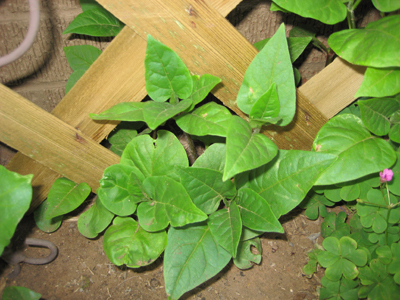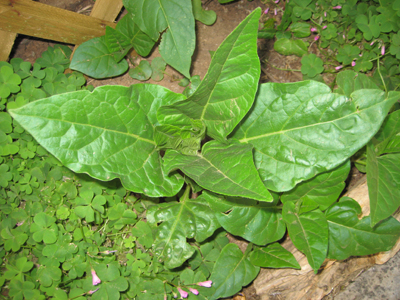We moved into this house we live in now in November of last year, so some of the plants that came up this spring have been a suprise. For the most part they are easy to identify and a Google search usually eases our mind. However there are these plants coming up in one of our flowerbeds that we have NO CLUE what they are.
We are hoping that everyone that frequents our blog can help us in trying to figure out what these guys are. We have a million of them coming up throughout the flowerbed and we would like to know. What if it is a deadly plant that we are keeping going because they are so green and abundant? I doubt that is the case, but we just would like to know ok!?
So here is a few pics of the unknown plants… come on gardeners HELP US OUT!



dude, id be lying if i told you i knew. you know me and vegetation arent on good terms. looks like a target for a bottle of roundup if you ask me.
ghost – if I ever need someone to murder my plants… I know who to call. Don’t know the name of it… well hit it with roundup then.
It reminded me of a photo I saw of NEW ZEALAND SPINACH, but I don’t think it is. Whatever it is, DON’T eat it. Here is the link to the photo , hope the link works:
New Zealand spinach
I will put your address on my post, so maybe someone will click through and recognize yours.
Thanks Barbee… it is in our flowerbed, so I figure it is something meant for ornamental purposes. Didn’t plan on eating it… regardless of the name. haha
We live in Texas if that helps in anyway.
Hi,
That looks a bit like Datura, but I’m not sure if the leaves can be that shiny…I know it can come up on it’s own.
From The Rock and Roll Gardener in Minnesota
I just thought of another strong possibility. Talinum paniculatum Common name: Jewels of Ophar sometimes spelled Ophir or something like that. Best to Google it by its scientific name so you will get hits on both spellings.
Here is a photo I found. Jewels of Ophar Ophar or Ophir was a wealthy region mentioned in the Bible. King Solomon used resources from there in the building of his temple. Info can be found in Bible concordance. A friend gave me some plants and told me to look it up in my concordance. I did.
It might be too invasive in your climate and situation. I like it here and I encourage it. when it comes up. I especially love seeing the low angled sunlight coming through the flowers and seed balls.
Google it and read a few hits.
Eesh, I’m not sure. I’d watch and wait, but keep an eye on it, because ghost could be right. When I saw new stuff come up in my garden when I moved in, it looked lovely and pretty, and those flowers all turned into monsters. If you want to see something scary, check out my project in progress, where each year I excavate the top 12″ of soil in a new area of the garden trying to eradicate the wild onions and wild garlic (I have both, I win!). It’s back breaking and expensive and not totally effective, but I’m SLOWLY winning the war. My point being, watch out for any signs it’s invasive. http://www.flickr.com/photos/nestmaker/2409866849/
This is an easy one, 4 O’Clocks, aka Mirabilis jalapa. The color will be a surprise when they bloom. I am betting they’ll be yellow or pink, odds on the yellow. They self seed prolifically and bloom all season. A real keeper. I have the yellow ones in my front garden sprouting everywhere. Love em and they were a passalong plant.
We talked about it and obviously whatever it is is super invasive – so we would want to work on it. I have pulled up some at one time and it has a dime sized or smaller seed or nut it comes from.
We see it poppin’ up here and there in totally random places. So we need to take care of it, probably will let it grow this year and then make that a project for next year.
Rock and Roll Gardener – thanks for stopping by, it is a tough one… thanks for the input.
Barbee – once again thanks, checked it out and it looks close… really have no clue.
Megan – holy cow that is a lot of work, better you than us. We have our own projects going as well, so we can definitely understand the work involved.
Tina – we are going to look at it some more and be sure, but it does look very similar. The stalks on some of them are big around as my thumb, no blooms yet however. We will keep an eye on them and see.
Thanks! To everyone so far.
I came over from Soliloquy . . . I love a puzzle!
At first glance it looked like four o’clock leaves to me (Mirabilis multiflora; Marvel of Peru); same leaf arrangement, and the plants self-sow. So I went searching around a bit and found a picture of the flower and leaves from davesgarden.com: http://davesgarden.com/guides/pf/showimage/149/
That’s my guess!
Like Tina and Nancy, I vote for four o’clocks. They do seed like that and the foliage is unmistakable. The stem usually does indicate the color, so you have a nice yellow. Pull most of them out, they get quite large, if you are trying to grow somethingelse in that bed.
Frances at Faire Garden
Yes James, It is a prolific self sower and the seeds are black and a bit smaller than a pea. Established plants grow from a tuber and can be difficult to eradicate. 4’o clocks are lovely, but need the right spot and need to be controlled. That being said, they bloom non-stop in my garden (evening hours) and are fragrant. The seeds sprout everywhere they can fall, even in cement cracks. Good luck getting rid of it! Probably some other unwary gardener planted it not knowing about its self seed tendency (like me). Fortunately it hasn’t take over and i don’t weed mine out. I planted some hardy guys with it like coneflowers and sedum and salvia. Good luck!
J – Thanks for your help, I think the mystery is solved.
Frances – Yellow even… thats cool. Good to know.
Tina – Sounds just like it. Seems like they are growing in every crack and spot you can think of. Thanks.
Ohhh, I love Four-o-Clocks. My mother had a few in a sheltered spot against the house in Tennesse and they came back every year, but didn’t spread. Here in KY z.6a, they die each winter unless the roots are taken up and wintered over somewhere safe.
i’m telling you, round up.
im a veritable foilage assassin.
Pingback: Weekend Projects @ Double Danger (Barbeque, Flowerbed Design, Gardening, Pool Deck Design) | Double Danger